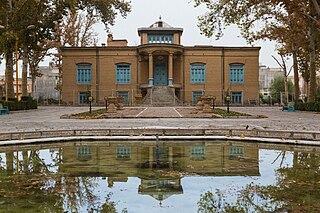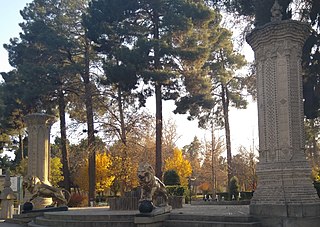
Nishapur or officially Romanized as Neyshabur is the second-largest city of Razavi Khorasan Province in the Northeast of Iran. Nishapur is situated in a fertile plain at the foot of Binalud Mountain Range and has been the historic capital of the Western Quarter of Greater Khorasan, the historic capital of the 9th-century Tahirid dynasty, the initial capital of the 11th-century Seljuk Empire, and is currently the capital city of Nishapur County and a historic Silk Road city of cultural and economical importance in Iran and the region of Greater Khorasan.
Abu Abd-Allah Muhammad ibn Abd-Allah al-Hakim al-Nishapuri, also known as Ibn al-Bayyiʿ, was a Persian Sunni scholar and the leading traditionist of his age, frequently referred to as the "Imam of the Muhaddithin" or the "Muhaddith of Khorasan."
Nishapuri or Nishaburi is a surname of Iranian origin. Notable people with the surname include:
The history of Nishapur begins with the city's founding during the Sasanian dynasty ; the city is located in the eastern province of Khorasan and served as the seat of the governor and commander in chief of the province.

The Jāmeh Mosque of Nishapur is the grand congregational mosque of the city of Nishapur in Iran. This mosque was founded by Pahlavan Ali Karkhi in 1493 during the rule of Husayn Bayqarah of the Timurid dynasty. This mosque was also rebuilt during the reign of Abbas the Great, the Safavid Shah of Persia. This mosque is part of the National Heritage List of Iran.
Keshavarz is a city and capital of Keshavarz District, in Shahin Dezh County, West Azerbaijan Province, Iran.

Fushenjan , also known as Pushtanghan or Pushenjan in the historic sources of The Quarter of Nishapur in Khorasan, is a village in Fazl Rural District, in the Central District of Nishapur County, Razavi Khorasan Province, Iran. At the 2006 census, its population was 1,457, in 421 families.
Hamidabad is a village in Fazl Rural District, in the Central District of Nishapur County, Razavi Khorasan Province, Iran. At the 2006 census, its population was 711, in 201 families.
Chah Varz Rural District is a rural district (dehestan) in Chah Varz District, Lamerd County, Fars Province, Iran. The rural district has 4 villages.
Quds or Beitol moghadas refer to the city of Jerusalem. This name is used in some Persian poems, ancient literature of Persia, geographical books, travel literature, and Persian atlases and maps.
Hamid Garmabi is an Iranian engineer and reformist politician who is currently a member of the Parliament of Iran representing Nishapur. He was chancellor of Amir Kabir University's Faculty of Engineering Polymer and Color before being elected as a parliament member.
Kiana Sādāt-Hosseini renowned as Little Kiana or Kiana of Nishapur also The Seven-year-old Kiana (2009–2016) was an Iranian seven-year-old Preschool student from Nishapur. She was kidnapped, raped and murdered by her aunt's husband Mehdi N on September 15, 2016. He was hanged in public 15 days later on September 30, 2016, in Nishapur with a special court order signed by Chief Justice Sadegh Larijani.
Tarikh-i Bayhaq is a book on the history of Bayhaq, written in the Persian language in the 12th century, by Abu'l-Hasan Bayhaqi.
Qadam Kheyr of the Qalavand tribe, was a notable Luri woman of the late Qajar and early Pahlavi period in Iran.
Abdolmohammad Ayati was an Iranian author, translator and researcher in the field of philosophy, history and Persian and Arabic literature. He was born on 5 May 1926 in Borujerd, Borujerd County, Lorestan Province, Iran and died on 11 September 2013 in Tehran, Iran. He was selected at the second Iran's Book of the Year Awards for Arabic to Persian translation of the book History of Arabic Language Literature.

The Khanate of Nishapur, also known as the Qara Bayat Amirdom, was a semi-independent state ruled by the Bayat tribe that existed in Khorasan from 1747 to 1800, whose capital was in the city of Nishapur.

The Shah Abbasi Caravansarai of Nishapur is a historical caravanserai built by the Safavid Empire and is located in the central part of the city of Nishapur. This caravansary was built by the order of the Abbas the Great, the Safavid Shah of Persia. This caravanserai is in the list of the national heritage of Iran. This caravanserai is now used as a tourist attraction and there are also several handicraft shops and two museums inside of it. This caravanserai is within Iran's National Heritage list with the registration number of 1230.
The 2022–23 Persian Gulf Pro League is the 40th season of Iran's Football League and 22nd as Persian Gulf Pro League since its establishment in 2001. The 2022–23 season will start on 11 August 2022 and featured 14 teams from the 2021–22 Persian Gulf Pro League and two new teams promoted from the 2021–22 Azadegan League: Mes Kerman and Malavan.

The Khanate Mansion and Garden of Amin Islami is one of the historical buildings and gardens of the city of Nishapur. The building was built in the Pahlavi era of Iran. This building is part of the Iranian national heritage list with the registration number of 4809.

The National Garden of Nishapur is a historic and a touristic Persian style garden and urban park close to the downtown of Nishapur. This garden is home to the city council of the city and the Nishapur branch of the CIDCA. This garden and the brick made monuments built in its northern entrance of this garden are part of the national heritage list of Iran with the registration number of 13364. Another historical registered site is also located in front of the northern section of this garden with the name of Khanate Mansion and Garden of Amin Islami.







